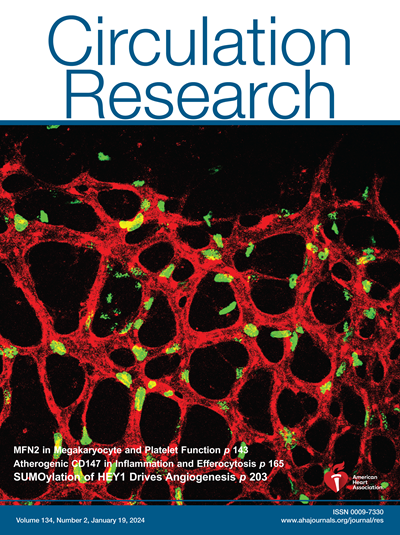Deficiency of Smooth Muscle ADAR1 Exacerbates Vascular Remodeling and Pulmonary Hypertension.
IF 16.2
1区 医学
Q1 CARDIAC & CARDIOVASCULAR SYSTEMS
引用次数: 0
Abstract
BACKGROUND ADAR1 (adenosine deaminase acting on RNA 1) catalyzes the conversion of adenosine to inosine in double-stranded RNAs, which is critical to prevent autoinflammatory responses mediated by activation of the type I IFN (interferon) signaling. We define the role of ADAR1-dependent RNA editing in IFNβ activation and pulmonary artery smooth muscle cell remodeling in pulmonary arterial hypertension, a devastating disease leading to right heart failure and death. METHODS RNA editing levels were analyzed in pulmonary arterial smooth muscle cells from idiopathic pulmonary arterial hypertension patients versus healthy controls. A conditional transgenic model, Adar1SMC-KO, was generated by knocking out Adar1 selectively in α-SMA (smooth muscle actin)-expressing cells, followed by 3 weeks of hypoxic exposure to induce PH. RESULTS Pulmonary arterial smooth muscle cells from patients with idiopathic pulmonary arterial hypertension displayed decreased levels of ADAR1 mRNA and isoform p150 protein, accompanied by accumulated double-stranded RNA compared with healthy pulmonary arterial smooth muscle cells. ADAR1 knockdown in pulmonary arterial smooth muscle cells upregulated MDA5 (melanoma differentiation-associated protein 5), PKR (protein kinase R), IFNβ, and IFN-stimulated genes. Compared with controls in vivo, hypoxic Adar1SMC-KO mice developed severe PH, as evidenced by excessive vascular remodeling in distal arterioles and increased endothelium leakage, resulting in elevated right ventricular systolic pressure and right ventricular hypertrophy. Mechanistically, Ifnβ signaling in Adar1SMC-KO induced the recruitment of macrophages, enhancing pulmonary artery muscularization. Pharmacological treatment with PKR-relevant inhibitor 2BAct decreased Ifnβ and macrophages, thus attenuating PH in hypoxic Adar1SMC-KO mice. CONCLUSIONS Our study describes a fundamental molecular mechanism underlying the progression of PH. We highlight the detrimental role of innate immune responses, where smooth muscle cell and context-specific RNA editing, along with the sensing of double-stranded RNA, mediate disease progression and excessive vascular remodeling. This finding suggests that targeting PKR could be the new therapeutic strategy for treating pulmonary arterial hypertension.平滑肌ADAR1缺乏可加重血管重构和肺动脉高压。
dadar1(作用于RNA 1的腺苷脱氨酶)在双链RNA中催化腺苷向肌苷的转化,这对于防止由I型干扰素信号激活介导的自身炎症反应至关重要。我们定义了adar1依赖性RNA编辑在肺动脉高压(一种导致右心衰和死亡的毁灭性疾病)中IFNβ激活和肺动脉平滑肌细胞重塑中的作用。方法分析特发性肺动脉高压患者与健康对照组肺动脉平滑肌细胞的srna编辑水平。通过在α-SMA(平滑肌肌动蛋白)表达细胞中选择性敲除Adar1,然后缺氧暴露3周诱导ph,生成条件转基因模型Adar1SMC-KO。结果特发性肺动脉高压患者的肺动脉平滑肌细胞与健康肺动脉平滑肌细胞相比,Adar1 mRNA和p150异型蛋白水平下降,并伴有双链RNA积累。肺动脉平滑肌细胞中ADAR1的下调上调了MDA5(黑色素瘤分化相关蛋白5)、PKR(蛋白激酶R)、IFNβ和ifn刺激基因。与体内对照组相比,缺氧的Adar1SMC-KO小鼠出现了严重的PH,表现为远端小动脉血管重塑过度,内皮细胞渗漏增加,导致右心室收缩压升高,右心室肥厚。机制上,Adar1SMC-KO中的Ifnβ信号诱导巨噬细胞募集,增强肺动脉肌肉化。用pkr相关抑制剂2BAct进行药物治疗可降低缺氧Adar1SMC-KO小鼠的Ifnβ和巨噬细胞,从而降低PH。我们的研究描述了ph进展的基本分子机制。我们强调了先天免疫反应的有害作用,其中平滑肌细胞和上下文特异性RNA编辑,以及双链RNA的感知,介导疾病进展和过度血管重塑。这一发现提示靶向PKR可能是治疗肺动脉高压的新治疗策略。
本文章由计算机程序翻译,如有差异,请以英文原文为准。
求助全文
约1分钟内获得全文
求助全文
来源期刊

Circulation research
医学-外周血管病
CiteScore
29.60
自引率
2.00%
发文量
535
审稿时长
3-6 weeks
期刊介绍:
Circulation Research is a peer-reviewed journal that serves as a forum for the highest quality research in basic cardiovascular biology. The journal publishes studies that utilize state-of-the-art approaches to investigate mechanisms of human disease, as well as translational and clinical research that provide fundamental insights into the basis of disease and the mechanism of therapies.
Circulation Research has a broad audience that includes clinical and academic cardiologists, basic cardiovascular scientists, physiologists, cellular and molecular biologists, and cardiovascular pharmacologists. The journal aims to advance the understanding of cardiovascular biology and disease by disseminating cutting-edge research to these diverse communities.
In terms of indexing, Circulation Research is included in several prominent scientific databases, including BIOSIS, CAB Abstracts, Chemical Abstracts, Current Contents, EMBASE, and MEDLINE. This ensures that the journal's articles are easily discoverable and accessible to researchers in the field.
Overall, Circulation Research is a reputable publication that attracts high-quality research and provides a platform for the dissemination of important findings in basic cardiovascular biology and its translational and clinical applications.
 求助内容:
求助内容: 应助结果提醒方式:
应助结果提醒方式:


